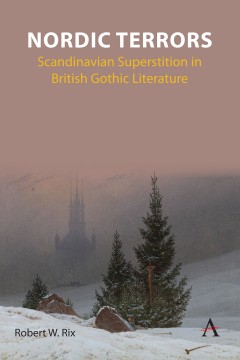Nordic Terrors
Scandinavian Superstition in British Gothic Literature
By Robert William Rix
Other Formats Available:
E-Book- About This Book
- Reviews
- Author Information
- Series
- Table of Contents
- Links
- Podcasts
About This Book
In late eighteenth- and early nineteenth-century British literature, Scandinavia emerged as a setting for Gothic terror. This book explores the extensive use of Nordic superstition as it provided a vocabulary for Gothic texts, examining the cultural significance these references held for writers exploring Britain’s northern heritage. In Gothic publications, Nordic superstition sometimes parallels the representations of Catholicism, allowing writers to gloat at its phantasms and delusions. Thus, runic spells, incantations, and necromantic communications (of which Norse tradition afforded many examples) could replace practices usually assigned to Catholic superstition. Yet Nordic lore did more than merely supplant hackneyed Gothic formulas; it presented readers with an alternative conception of ‘Otherness’. Nordic texts—chiefly based on the Edda and the supernatural Scandinavian ballad tradition—were seen as pre-Christian beliefs of the Gothic (i.e., Germanic) peoples, including the Anglo-Saxons. The book traces the development of this Nordic Gothic, situating it within wider literary, historical, political, and cultural contexts.
A significant context explored in the book is the conflict between the respective supporters of Celtic and Germanic heritage in the British Isles. The critical interventions of the Hugh Blair, John Pinkerton, Thomas Percy and others are important for understanding the role Norse tradition came to play. Among supporters of the Gothic/Germanic past, the Norse ancestors’ undaunted confrontation with fear was hailed as a testament to the bravery and boldness of the race. In turn, the terror discovered in Norse tradition was made to do cultural work as an ethno-political intervention in favour of Anglo-Saxon heritage in Britain.
Another context for the Nordic imaginary is the commercial book market. British writers often teetered between approaching Nordic superstition with genuine antiquarian interest and exploiting it for the shock effects it afforded. With respect to the dual investment in Nordic material, a central focus is the Danish ballad material included in Matthew Gregory Lewis’ The Monk and his Tales of Wonder. Other writers who are discussed include Thomas Gray, Thomas James Mathias, William Wordsworth, Anna Seward, Walter Scott, and Ann Radcliffe. The book will also introduce readers to lesser-known authors.
Reviews
A masterpiece of academic scholarship, informed and informative, deftly organized and thoroughly 'reader friendly' in presentation, "Nordic Terrors" is especially and unreservedly recommended for college/university library Gothic Literary Criticism collections and supplemental curriculum studies lists.—Midwest
“This fascinating book throws welcome new light on how much the dark horrors of British gothic literature owe to Nordic – Norse and Scandinavian – myths, legends and folklore. Rix demonstrates how the celebrated ‘Otherness’ of gothic fiction was countered and enriched by a sense of the shared Nordic past amongst English-speaking authors and readers.” —Heather O’Donoghue, Oxford University, UK.
“This is an interesting and meticulously researched study that combines a discussion of tales of terror set in Nordic lands with an examination of the infl uence of Nordic superstition on the British Gothic, and, more extensively, on the negotiation of British identity and culture. Hence, it offers not only a fascinating critical ramble in cold and strange Northern lands but also a sombre stroll in the familiar drizzle of British identity, making us experience both differently in the process.” —Tabish Khair, Aarhus University, Denmark.
“Nordic Terrors delves into the literary entanglements surrounding Gothic writing in Britain. Robert Rix shows how Old Norse poetry and Danish balladry infuse what ends up as British Gothic literature with heroic masculinity, evil elves, ghosts, hags, and frost giants, creating scenes of terror while also negotiating notions of British cultural heritage and national identity.” —Elisabeth Oxfeldt, University of Oslo, Norway
Rix adeptly shows how complicated, contested, and contradictory the process of ethnic and national identity formation is, and how central a role the speculative imagination plays.[...] Nordic Terrors is especially compelling in describing how the British Gothic defined and wrestled with “the Other .—Ancillary Review of Books
Author Information
Robert W. Rix is Professor and Director of Research at the University of Copenhagen. He is widely known for his numerous publications on eighteenth- and nineteenth-century literature and culture.
Series
Anthem Studies in Gothic Literature
Table of Contents
Introduction ; Chapter 1: Discovering Britain’s “Gothic” Past; Chapter 2: Ballads across Borders: Terrors, Translations, Travesties; Chapter 3: Norse Pasts and British Presents; Conclusion
Links
Stay Updated
Information
Latest Tweets



